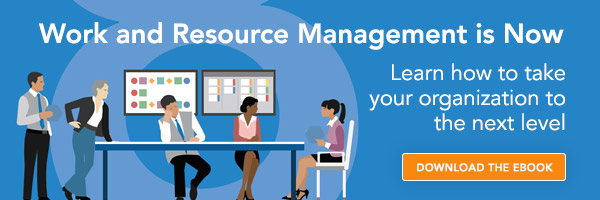
We live in a fast-paced, technological world, characterized by seemingly endless changes to work and resource dynamics. Teams are spread out across departments and locations, with individuals often approaching work in very different ways. This means executives are faced with delivering on corporate strategy while remaining flexible and promoting an adaptive organization. However, with all these changes and moving parts, this task may seem impossible without effective work and resource management.
So, how can executives and senior leaders keep up with the evolving workplace and also actively participate in driving work transformation? Ventana Research CEO and Chief Research Officer, Mark Smith, addresses this dilemma as part of an in-depth Q&A on work and resource management:
1. “C-level and executive teams must consider strategies and plans to adapt to the changing dynamics of work and resources. What are the pressing challenges they should be concerned about?”
Challenge 1: addressing the changing demands of work. As stated above, this has become increasingly difficult. To address these changes, C-level and executive teams must ensure that the strategic programs and projects being launched increase business and market potential—they must be well-managed and well-designed.
Challenge 2: the ongoing increase in the automation of business processes. As a result, unautomated processes have become poorly defined, creating an intensified focus on unstructured work. Executives must develop a relevant approach that shows they understand how the average work day is changing and are able to incorporate processes for continuous optimization.
Challenge 3: the elevation in expectations of accountability. This elevation is a result of the heightened performance demands of today’s market. Consumers want products quickly and want their needs met. Having the right work and resource management processes will allow executives to not only meet but exceed these expectations.
Challenge 4: sharper scrutiny on measures of outcomes. In order to deliver the desired outcomes, executives must create a strong alignment of work to enterprise strategy. How else can you properly measure outcomes and compare final results to the organizational goals?
2. “What obstacles do executives face in trying to address these challenges?”
Obstacle 1: silos within the traditional departmental structure. Proper visibility across the organization would allow individuals to better work together and achieve strategic outcomes; unfortunately, this level of visibility is often lacking. As a result, work and resources are not managed in a way that is tightly aligned to the strategy and goals of the organization.
Obstacle 2: ad-hoc management of non-repetitive or unstructured work. This compounds the negative impact of the siloed business environment. Processes from task definition and tracking to completion are often left up to managers, rather than shared visibly across the organization. This makes room for uncertainties to creep in and causes the organization to become dependent on intangibles such as the skills and effectiveness of its people—not exactly a vote of confidence in the organization’s ability to achieve efficiency and effectiveness.
Don’t let these obstacles get you down—they’re not as difficult to overcome as they seem. Instead focus on this goal:
Improve sharing of resources and collaboration across projects and teams.
This way C-level and executive teams can not only address the changing environment of work and resources, but will also be able to optimally utilize resources, deliver improved results, and control levels of financial investment. To achieve this level of collaboration and visibility, executives must direct leadership to identify and acquire the right work methodologies—ones that empower people to understand their work and track their progress. In supporting an interconnected and continuous approach to managing work and resources, the organization will be better able to deliver on business strategy and overcome existing obstacles.
To gain more insight on executive perspectives on work and resource management, read the rest of the blogs in this series, listed below:
- Part 2: An Executive Perspective on the Role of Work and Resource Management Technology
- Part 3: An Executive Perspective on Aligning WRM with Digital Transformation Priorities
- Part 4: An Executive Perspective on the Benefits of Work and Resource Management
- Part 5: An Executive Perspective on Getting Started with Work and Resource Management
Also, check out www.planview.com to learn more about work and resource management and some of the solutions that can help you get started.






